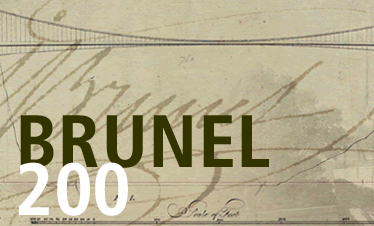
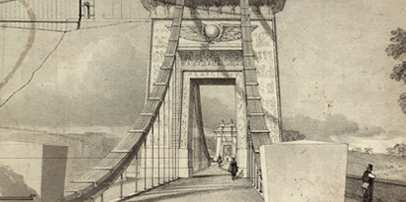

Entrance to Thames Tunnel
(National Trust)
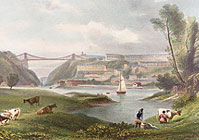
Artist’s impression of Clifton
Suspension Bridge (National Trust)
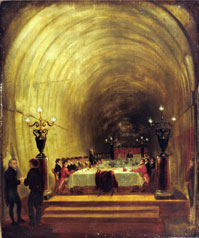
Thames Tunnel Banquet
(Elton Collection: Ironbridge Gorge
Museum Trust)






The
1820s
In 1820, Isambard Kingdom Brunel travelled to France to acquire a more
thorough academic grounding in his chosen field (there was no formal engineering
training in Britain until the mid-nineteenth century).
He studied at the College of Caen in Normandy and the Lycée Henri
Quatre in Paris. He also served an apprenticeship with Abraham Louis Breguet,
a master-craftsman skilled in the making of watches and scientific instruments.
Brunel returned to Britain on 21 August 1822 and joined his father’s
drawing office at 29 Poultry Lane, London where he gained practical experience
to complement his formal training. One of the projects his father passed
over to him was the development of a gaz engine that Marc hoped would
come to replace the steam engine: Brunel persevered with the project for
several years but eventually abandoned it. While working in his father’s
office, Brunel also made regular visits to the works of the engineers
Maudslay, Son and Field in Lambeth to widen his experience.
Brunel was an ambitious young man, looking for fresh challenges, who chose
for his motto En Avant – Get Going. He readily admitted to his need
to be seen as important, perhaps in part compensating for his lack of
physical stature (he was 5ft 3in/1.60m tall). He wrote in his diary:
My love of glory is so strong, even on a dark night, riding home,
when I pass some unknown person who perhaps does not even look at me,
I catch myself trying to look big on my little pony… I often do
the most silly, useless things to attract the attention of those I shall
never see again.
His admirers would later give him the nickname Little Giant. He was always
willing to take risks and was prepared to invest his own money in his
schemes as a point of principle, leading to occasional good fortune but
also heavy losses.
In 1824, the Thames Tunnel Company was formed with Marc as its chief engineer
and the Brunel family moved from fashionable Chelsea to the less salubrious
Blackfriars. Construction of the tunnel began on 2 March 1825. Brunel
was formally appointed its resident engineer on 3 January 1827. Despite
his youth and lack of experience, he had been supervising work on the
project for some time, gaining the respect of his men through his dedication
and bravery. On 10 November 1827, Brunel organised a grand banquet in
the tunnel to celebrate the resumption of work after a serious flood six
months previously: 50 invited guests and 120 miners attended. The walls
were hung with crimson drapes and candles blazed while the band of the
Coldstream Guards played. This was an early example of Brunel’s
awareness of the value of making a grand public gesture to generate interest
in his work. Through his involvement with the Thames Tunnel, Brunel discovered
his self-confidence and capacity for leadership, and he emerged from the
project as a fully equipped engineer. (Read more about the Thames Tunnel
on the Major Projects page).
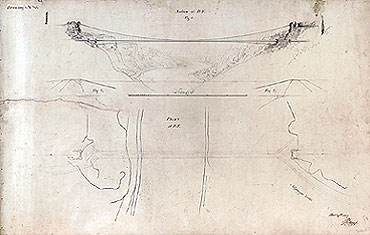
One of Brunel’s submissions for the Clifton Bridge
competition
(University of Bristol)
In January 1828, Brunel was seriously injured during a major flood at
the tunnel in which six men drowned. His knee was badly damaged by a falling
timber and he also suffered internal injuries. When he was well enough
to travel, Brunel spent his convalescence in Brighton and Bristol, where
he heard of plans to build a bridge across the Avon at Clifton. In March
1831, one of Brunel’s designs submitted for the second Clifton Suspension
Bridge competition was formally awarded first prize and a ceremony to
mark the laying of the foundation stone on the Clifton side of the gorge
took place on 21 June. In October that year, Brunel was sworn in as a
special constable during the Bristol Riots, which were centred on Queen
Square. He actually arrested a man who he unwittingly passed over to a
fellow rioter disguised as a constable. The disruption caused by the rioting
contributed to delays in the construction of the bridge as business confidence
in the city fell. Although work was eventually resumed and the foundation
stone for the abutment on the Leigh Woods side of the gorge was laid on
27 August 1836, the bridge was not completed until 1864 following another
long period of inactivity. (Read more about the bridge on the Clifton
Suspension Bridge page).
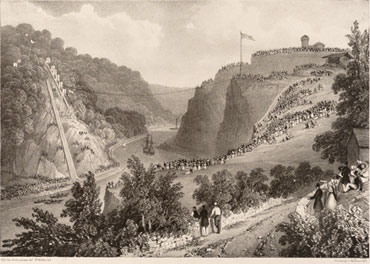
Ceremony of laying foundation stone at bridge (Private
collection)
